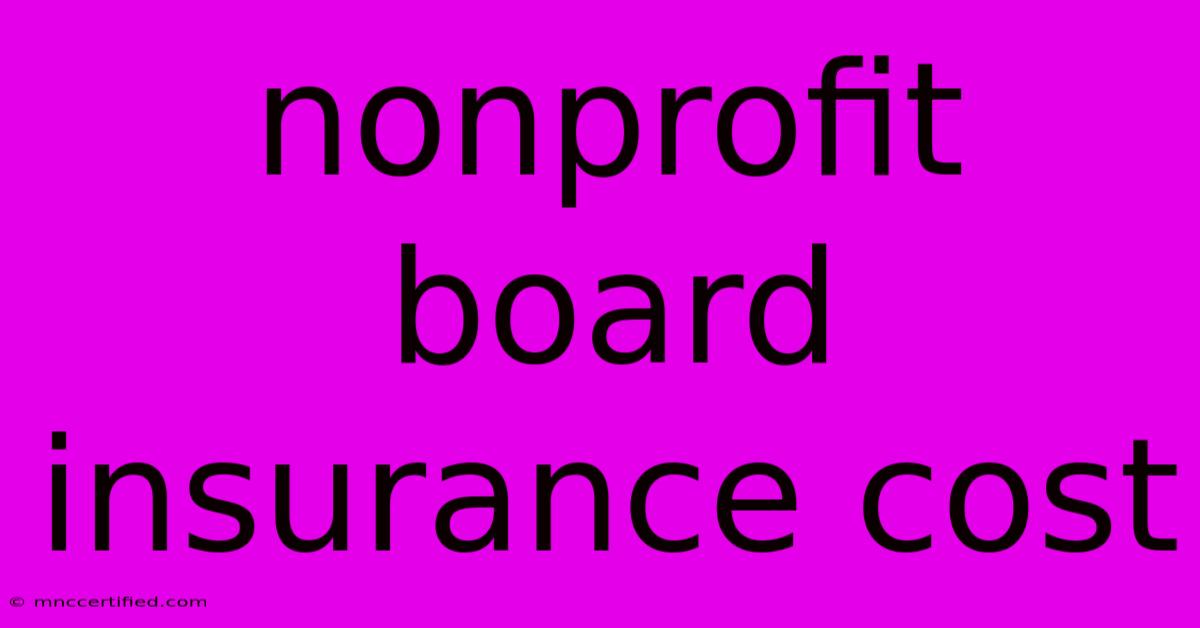Nonprofit Board Insurance Cost

Table of Contents
Nonprofit Board Insurance Cost: A Comprehensive Guide
Protecting your nonprofit's board of directors is crucial. The cost of nonprofit board insurance, however, can vary significantly. Understanding the factors influencing this cost and how to find affordable yet comprehensive coverage is key to responsible governance. This guide breaks down the essentials of nonprofit board insurance, its cost components, and how to navigate the process of securing the right policy.
Understanding Nonprofit Board Insurance
Nonprofit board insurance, often called Directors & Officers (D&O) liability insurance, protects your board members from personal financial liability stemming from wrongful acts or omissions in their duties. This crucial coverage shields individual directors from lawsuits, settlements, and legal fees related to their actions or inactions while serving on the board. Without it, directors face the risk of significant personal financial ruin.
Think of it as a safety net—a critical layer of protection for your invaluable volunteer leadership.
Factors Affecting the Cost of Nonprofit Board Insurance
Several factors influence the premium you'll pay for D&O insurance:
1. Size and Type of Nonprofit:
Larger nonprofits with more complex operations and higher budgets generally pay more. The type of nonprofit also plays a role; organizations in high-risk sectors (e.g., healthcare, finance) may face higher premiums.
2. Location:
Insurance costs vary by geographic location due to differences in legal environments and claims history. States with higher litigation rates may command higher premiums.
3. Claims History:
A history of prior claims significantly impacts premiums. Even a single claim can lead to a substantial increase in future premiums. Strong risk management practices are essential to mitigate this risk.
4. Coverage Limits:
Higher coverage limits naturally translate to higher premiums. Choosing the right coverage amount requires careful consideration of potential liabilities and risk assessment. Consult with an insurance broker to determine the appropriate level of coverage for your nonprofit.
5. Deductible:
Similar to other insurance types, choosing a higher deductible will usually lower your premium. However, it increases your out-of-pocket expense if a claim arises. Finding the right balance between premium cost and deductible is vital.
6. Insurer:
Insurance companies have different underwriting criteria and pricing structures. Comparing quotes from multiple insurers is essential to secure the most competitive rate.
How to Reduce Nonprofit Board Insurance Costs
While you can't completely eliminate the cost, several strategies can help lower premiums:
- Implement Strong Risk Management Practices: Proactive risk management, such as robust governance policies, thorough due diligence, and comprehensive training for board members, can significantly reduce the likelihood of claims and, consequently, lower premiums.
- Negotiate with Insurers: Don't hesitate to negotiate with multiple insurers. Highlight your strong risk management practices and favorable claims history to potentially secure a better rate.
- Explore Package Policies: Some insurers offer package policies combining D&O liability with other essential coverages like employment practices liability insurance (EPLI). Bundling policies can sometimes lead to savings.
- Consider Your Coverage Needs Carefully: Avoid over-insuring. While adequate coverage is crucial, obtaining excessive coverage unnecessarily increases premiums. Work with a broker to determine the optimal level of protection.
Finding the Right Nonprofit Board Insurance
The process of securing the right policy involves:
- Identify Your Needs: Assess your nonprofit's specific risks and potential liabilities.
- Consult with an Insurance Broker: An experienced broker specializing in nonprofit insurance can help you navigate the complexities of the market and find the best coverage at a competitive price. They can compare quotes from multiple insurers and advise on the appropriate level of coverage.
- Compare Quotes: Don't settle for the first quote you receive. Compare quotes from several reputable insurers to ensure you're getting the best value.
- Review the Policy Carefully: Before committing to a policy, carefully review the policy document to understand the terms, conditions, exclusions, and coverage limits.
Conclusion
The cost of nonprofit board insurance is a crucial consideration for any organization. By understanding the factors influencing cost, implementing strong risk management practices, and working with a knowledgeable broker, nonprofits can secure affordable and comprehensive coverage that protects their valuable board members and ensures the organization's long-term sustainability. Remember, the cost of not having adequate insurance far outweighs the premium you pay.

Thank you for visiting our website wich cover about Nonprofit Board Insurance Cost. We hope the information provided has been useful to you. Feel free to contact us if you have any questions or need further assistance. See you next time and dont miss to bookmark.
Featured Posts
-
Physician Economist Bhattacharya Receives Nomination
Nov 27, 2024
-
Joel Prelog Fisher Investments
Nov 27, 2024
-
Celta Vigo Barcelona Player Absence Risk
Nov 27, 2024
-
Gofundme Is Not Life Insurance
Nov 27, 2024
-
Wildlife Photographer Final 25 Images
Nov 27, 2024